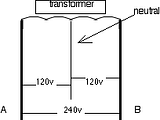Re: Question about circuit breakers and 220v vs 110v???
Good question!<br /><br />No. It works kind of like 24vdc on a boat. If you put a pair of 12v batteries (i.e. two 12v sources) in series you can measure 24v on the line. When two 120vac lines are brought together one of two things happens; either you can measure 120vac on the line if both lines are in the same phase (i.e., from the same source, the side of the transformer in Fireship1s example above), or you can measure 240vac if both 120vac lines are out of phase, i.e. from different sources, one from each side of the transformer. Each phase is often referred to as a pole. The key to getting 24vdc on a boat or 240vac in an appliance is TWO sources for the power.<br /><br />In a 240vac dryer, two out-of-phase 120vac lines are coming together somewhere. You can measure 240vac, because both 120v hots are using the same neutral. There is 240v inside of a 240v appliance.<br /><br />Traditionally, 240vac required 3 lines and plugs with 3 prongs; 120v hot pole-1, 120v hot pole-2, and a shared neutral. Thats changing. 240vac will be 4 lines and use plugs with 4 prongs. Whats being added is the green wire, the safety ground that is in your household 120vac wall receptacles, the round hole. The neutral in the new 240vac plugs will stay shared, i.e. it will still carry 240v on it.Originally posted by KenImpZoom:<br /> So it is actually wrong to call an appliance a 220V, it is really a double 110v, with the two 110v lines 180 degrees apart.




















